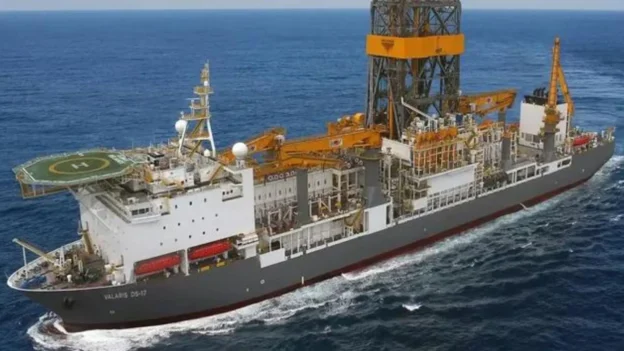After two months of intense work, the Valaris DS 17 has completed the drilling of the Argerich well, obtaining an achievement as the first ultra-deepwater well in the Argentine Sea. well in ultra-deep waters of the Argentinean Sea. . Located about 300 km off the coast of Mar del Plata, this project seeks to discover a vast oil field. The initiative is led by the Norwegian company Equinor, in collaboration with YPF and Shell.
Valaris DS 17 vessel work is completed
As for the details of the operation, industry sources confirmed to the +e portal that the drilling was completed in less than the 60 days foreseen, despite the fact that the Nation had authorized a possible extension. After drilling was completed, the Argerich well was sealed and now the geological samples obtained will be analyzed to evaluate the productive potential of the Cuenca Argentina Norte (CAN) 100 block.
It is important to note that the vessel Valaris arrived in Mar del Plata on April 23 and, after completing its work, is now anchored near the coast, preparing to return to Brazil. In this operation, the ships HOS Remington and Skandi Caledonia provided assistance to the Valaris.
Characteristics of the first ultra-deep water well
The Argerich well, located 311 km from the port of Mar del Plata, is a pioneer in the country as it was drilled at a depth of 2,500 meters above the seabed, with a diameter of 106 centimeters at the sediment surface. The drilling reached a total depth of more than 4,000 meters.
Work began in December with the arrival of the BGP Prospector vessel, responsible for conducting 2D and 3D seismic surveys over an area of 15,000 km², with a depth of 1,527 meters to the seabed.
The objective of this initial stage is to study the resource potential in the area and to obtain a more detailed knowledge of the subsurface. If hydrocarbons are found, a second stage will be carried out to establish the limits of the reservoir using wells designed to test the fluid to be extracted. In a third stage, production drilling could begin.
Expectations and track record in the offshore industry
The offshore offshore has aroused great interest in the Argentine oil industry. The technicians base their expectations on 3D seismic logs conducted by YPF in 2006 and 2007 and additional studies between 2017 and 2018 by the company Spectrum. These reports suggest the possibility of finding a significant hydrocarbon reserve.
An encouraging precedent is the discovery of the Venus field by TotalEnergies offshore Namibia. The North Argentina Basin was formed during the separation of South America and Africa some 150 million years ago and is considered a mirror basin of the Namibian coast due to similar processes of sedimentation and organic deposition. This parallelism increases the probability of finding hydrocarbons in the North Argentina Basin.
Follow us on social networks and don’t miss any of our publications!
YouTube LinkedIn Facebook Instagram X
Source and photo: mase.lmneuquen

